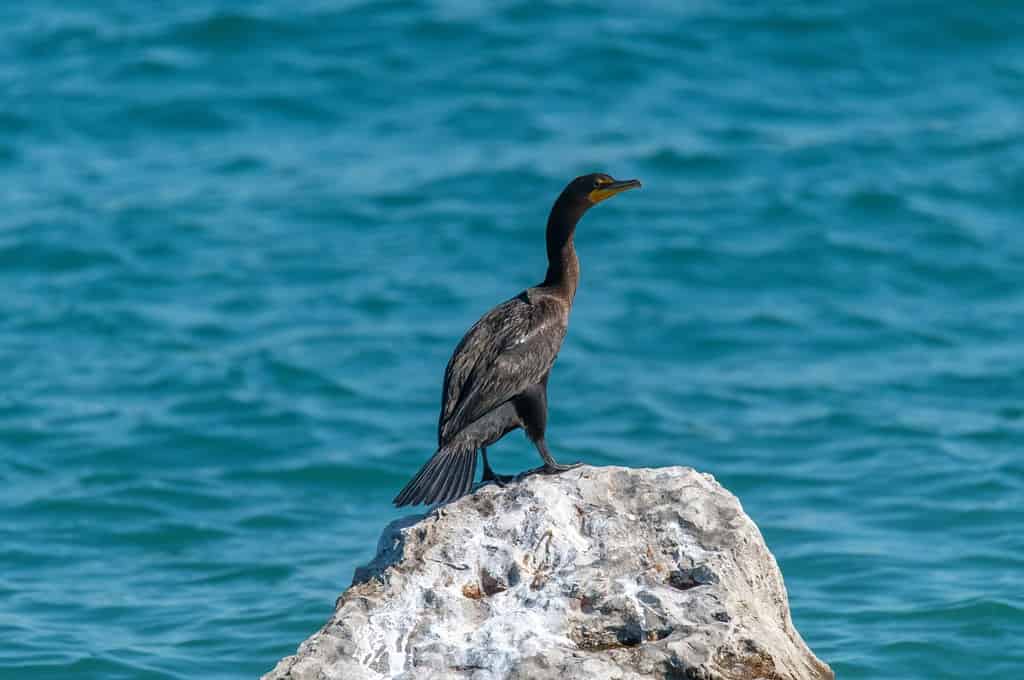
The post This Bird Manages to Gulp Down a Huge Fish Bigger Than Its Whole Head appeared first on A-Z Animals.
You know that feeling when you’re especially hungry and want to eat as much as possible, but your mouth is only so big? Well, some animals don’t have that problem! Unlike humans with our relatively small mouths, certain animals have much larger mouths compared to their heads, allowing them to swallow enormous amounts of food. Take the cormorant in this YouTube video, for example: it somehow manages to gulp down a fish that’s bigger than its entire head!
Meet the Cormorant

Cormorants dive for fish in freshwater and saltwater.
©James W. Thompson/Shutterstock.com
Cormorants belong to a scientific family of about 40 species of waterbirds known as Phalacrocoracidae. These birds have large bodies, long necks, and small heads. Cormorants are found worldwide, and in North America, the double-crested cormorant (Nannopterum auritum) is the most common and widespread species. In Ireland and Britain, you’ll mainly find the common shag (Gulosus aristotelis) and the great cormorant (Phalacrocorax carbo).
Cormorants are mainly black with yellow-orange coloring around their faces and bills. Depending on the species, cormorants typically weigh between 1 and 11 pounds and have a wingspan of 2 to 3 feet. You might spot them swimming low in the water or standing along the shore with their wings spread out as they dry their feathers in the sun. Their feathers aren’t completely waterproof, which helps them dive efficiently, but it also means they need to dry their feathers in the sun to stay warm once they’re out of the water.
The Cormorant’s Preferred Prey

Although they usually spend time in flocks, cormorants also sometimes hunt alone.
©YouTube/Mark Smith – Original
Cormorants are excellent divers and exclusively eat fish. They are opportunistic hunters and prefer fish that are easy to catch. They typically hunt small to medium-sized fish, up to 6 inches long, such as perch, sticklebacks, sculpin, trout, herring, minnows, and shad. Occasionally, they will tackle larger prey like eels, pike, and carp. Some cormorants have been spotted trying to swallow eels nearly as long as their own bodies!
Cormorants dive from the water’s surface, propelling themselves underwater with their webbed feet. They usually dive no more than 25 feet deep, though some species can go as deep as 150 feet. On average, a cormorant consumes about 1 pound of fish each day.
Cormorants use their long, hooked bills to grasp their prey. Some will swallow fish underwater, while others bring their catch to the surface to get a better grip.
How Cormorants Tackle Large Fish
Cormorants have many unique adaptations that allow them to swallow fish surprisingly large for their size, including their uniquely designed skull and extra-flexible esophagus.
Uniquely Designed Skulls

Unlike many other birds, cormorants have dense and heavy bones.
©YouTube/Mark Smith – Original
Cormorants’ skulls are specially designed for swallowing large fish. They have a bone at the back of their skull called the os nuchale, also known as the occipital style. This bone anchors strong muscles that help them close their lower jaw with greater force. Cormorants’ skulls are also “kinetic,” meaning their upper jaw can move independently from the rest of the skull. This gives them better control over their beak and jaw movements when catching, manipulating, and swallowing fish. In addition, a hinge-like quadrate bone in their skull allows for a much larger range of motion in their mouth when trying to swallow especially large fish.
Flexible Esophagus

A group of cormorants is called a “flock” or a “gulp.”
©YouTube/Mark Smith – Original
Their trachea (windpipe) and esophagus (food pipe) are positioned to the side of the neck, rather than running straight down the middle. Unlike in reptiles and mammals, the muscles in cormorants do not restrict the movement of these tubes. This allows for much more flexibility when swallowing large fish. It also ensures that the bird’s airway remains clear, preventing suffocation when swallowing larger prey.
The inside of a cormorant’s esophagus is also lined with backward-facing bumps called papillae. These help to grip and guide slippery animals like fish and eels down the bird’s digestive tract.
While smaller fish can be swallowed underwater, larger fish require more leverage, so the cormorant must return to the surface. As shown in the YouTube video, the bird may toss and flip the fish around to position it head-first. This is important because most fish scales point backward, so swallowing the fish head-first allows the scales to slide down smoothly without getting caught.
Once the fish is in the correct position, the cormorant uses a series of coordinated muscle actions to swallow it. Like the bird in the video, cormorants will often toss their head and neck around, using gravity and the fish’s own downward momentum to help swallow it.
The post This Bird Manages to Gulp Down a Huge Fish Bigger Than Its Whole Head appeared first on A-Z Animals.
May 30, 2025 at 05:32PMKellianne Matthews
.jpeg)
.jpeg)

0 Comments